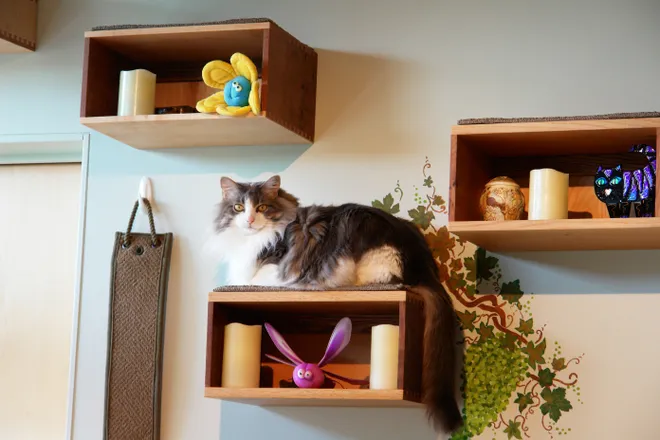Cats, with their unique behaviors and instincts, thrive in environments that prioritize their comfort and natural inclinations. To transform your home into a haven for your feline companion, consider these detailed tips that cater to their well-being and happiness:
1. Vertical Space and Perching Areas
Cats are natural climbers and enjoy surveying their surroundings from high vantage points. Install cat trees, shelves, or wall-mounted perches at varying heights to accommodate your cat’s desire for elevated spaces. Providing vertical territory satisfies their climbing instincts and allows them to feel secure and in control of their environment.
Consider creating multi-level perching spots near windows to offer entertainment through observing outdoor activities, such as birdwatching. These areas become cozy retreats where your cat can bask in sunlight and observe the world.
2. Environmental Enrichment and Interactive Play
Stimulating your cat’s mind and body is crucial for their overall well-being. Offer a diverse range of toys that mimic prey behavior, such as wand toys, puzzle feeders, and balls to chase. Rotate toys regularly to keep their interest piqued and engage in interactive play sessions to foster a strong bond and provide mental and physical exercise.
Consider DIY enrichment activities like hiding treats in puzzle toys or creating obstacle courses using household items to encourage exploration and mental stimulation.
3. Scratching Posts and Claws Maintenance
Scratching is a natural behavior that helps cats stretch, mark their territory, and maintain their claws. Provide sturdy and varied scratching posts or pads made from different materials like sisal, carpet, or cardboard. Place these posts strategically around the house, especially near favorite resting spots or entryways, to redirect their scratching instincts away from furniture.
Regularly trim your cat’s nails and offer appropriate outlets for scratching to prevent furniture damage and maintain their claws in good condition.
4. Safe Hideaways and Quiet Spaces
Cats appreciate having safe and secluded areas where they can retreat and feel secure. Provide cozy hiding spots such as enclosed beds, igloo-style cat caves, or cardboard boxes lined with soft blankets or cushions. Place these hideaways in quiet corners or elevated spots, allowing your cat to observe while feeling protected.
Ensure these spaces remain undisturbed, creating a sanctuary for your cat to relax and recharge.
5. Litter Box Accessibility and Placement
Litter box placement is crucial for maintaining your cat’s litter habits. Place multiple litter boxes in quiet, easily accessible areas away from high-traffic zones and feeding stations. Consider providing one litter box per cat plus an additional box to accommodate their preferences.
Maintain cleanliness by scooping the litter box regularly and performing thorough cleanings to ensure your cat feels comfortable using their designated elimination area.
6. Visual Stimulation and Outdoor Views
Offer your cat opportunities to observe the outside world from the safety of your home. Create window perches with comfortable cushions or place cat trees near windows to allow your cat to enjoy natural light and observe outdoor activities.
Consider placing bird feeders, bird baths, or plants near windows to provide visual stimulation and entertainment, keeping your cat engaged and mentally stimulated.
7. Safe Plants and Exploration Opportunities
Introduce safe indoor plants that are non-toxic to cats to create a natural and stimulating environment. Offer exploration opportunities through interactive toys, cat tunnels, or DIY cardboard forts that encourage curiosity and movement.
Rotate and vary these enrichment tools to maintain your cat’s interest and prevent boredom.
8. Feeding Stations and Water Sources
Establish separate feeding stations for your cat, keeping them away from litter boxes to maintain hygiene. Elevated feeding platforms can prevent whisker fatigue and offer a comfortable dining
experience. Consider puzzle feeders or slow-feed bowls to provide mental stimulation during meal times.
Place water bowls in multiple locations throughout the house to encourage hydration and ensure access to fresh water at all times.
9. Cat-Friendly Furniture and Protection
Invest in cat-friendly furniture or protective coverings for your belongings. Choose durable, washable materials that withstand scratching and are easy to clean. Provide designated spaces or scratching posts near furniture to redirect your cat’s scratching behavior.
Utilize cat-proofing products like sticky tape, deterrent sprays, or double-sided tape to protect furniture from unwanted scratching.
10. Consistency, Patience, and Affection
Maintaining a consistent routine is vital for your cat’s well-being. Cats thrive on predictability, so establish regular feeding, play, and quiet times to create a sense of security and stability.
Be patient when implementing changes in their environment during the adjustment period, allowing your cat time to acclimate to new additions or alterations.
Lastly, shower your cat with love, affection, and positive reinforcement. Spend quality time bonding with your feline friend through cuddles, gentle strokes, and verbal reassurance to strengthen your relationship and create a loving and trusting environment.
In conclusion, creating a cat-friendly home involves a thoughtful approach to considering your cat’s instincts, preferences, and needs. You’re cultivating a harmonious space where your beloved feline can thrive and flourish by providing an enriching environment that fosters mental stimulation, physical activity, and a sense of security.

